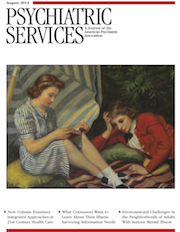Comparing Neighborhoods of Adults With Serious Mental Illness and of the General Population: Research Implications
Abstract
Objective
The International Classification of Functioning, Disability and Health emphasizes the importance of assessing the impact of environmental factors on functioning and disability. Drawing on this emphasis, this study used a set of objective measures to compare the characteristics of neighborhoods of adults with serious mental illness and of the general population. It also examined the relationship between neighborhood characteristics and neighborhood concentration of persons with serious mental illness.
Methods
The sample comprised 15,246 adults who were treated for serious mental illness in Philadelphia between 1997 and 2000. Principal-components analysis of 22 neighborhood characteristics resulted in an ideal-factor solution of six components. The mean values of each component in neighborhoods of persons with serious mental illness were compared with values in an equally sized group of neighborhoods created by randomly generated addresses representative of the city’s general population. Ordinary least-squares regression was used to assess the association between neighborhood characteristics and neighborhood concentration of persons with serious mental illness.
Results
Neighborhoods in which adults with serious mental illness resided had higher levels of physical and structural inadequacy, drug-related activity, and crime than comparison neighborhoods. Higher levels of physical and structural inadequacy, crime, drug-related activity, social instability, and social isolation were associated with higher concentration of persons with serious mental illness in the neighborhood’s adult population.
Conclusions
The differences in neighborhood characteristics identified in this study point to factors that merit closer attention as potential barriers or facilitators in the functioning, participation, and community integration of persons with serious mental illness.



